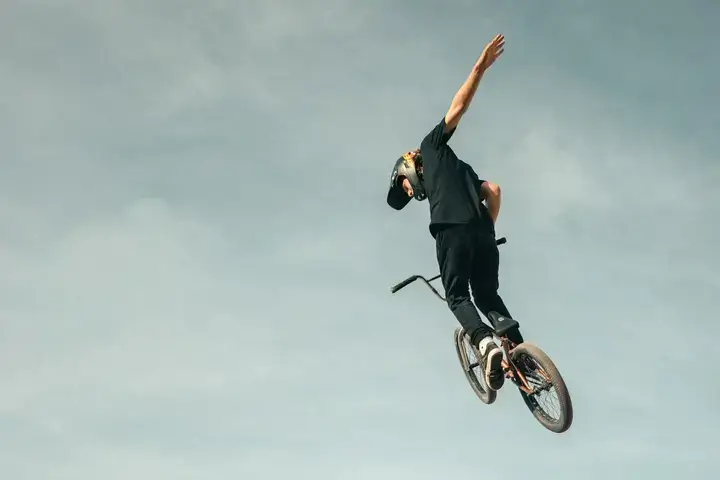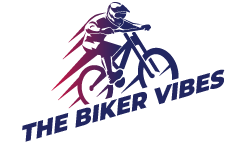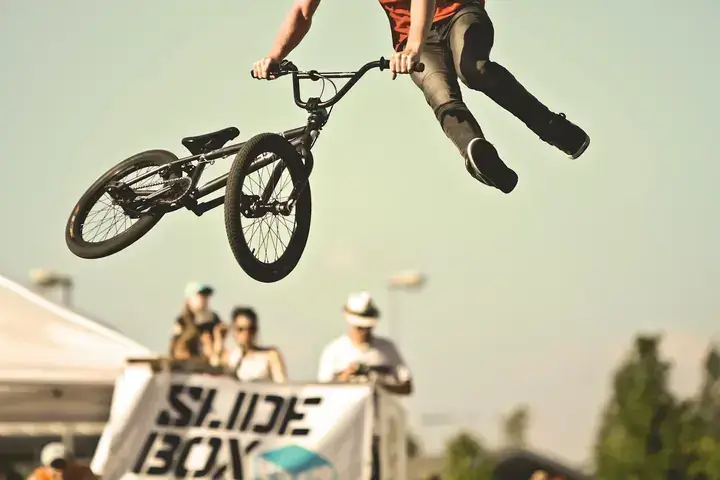What is a Tail whip?
A tail whip is a BMX trick that involves spinning the bike frame 360 degrees while simultaneously kicking the back end (or “tail”) around. It’s a crowd-pleaser that demands a combination of skill, balance, and perfect timing. Before attempting this trick, ensure you have a solid grasp of basic BMX riding, including maintaining balance and controlling your bike in mid-air.
The Dance of Skill and Style
What sets the Tail Whip apart is the seamless integration of skill and style. Executing a perfect tail whip isn’t just about technical prowess; it’s about infusing personal flair into the trick. Riders bring their own unique spin to the maneuver, incorporating body movements, bike positioning, and even variations in the whip’s speed. This fusion of skill and style transforms the tail whip into a dynamic and expressive form of self-expression on two wheels.
Importance of Balance and Control
Executing a tail whip successfully requires impeccable balance and control. Riders should feel comfortable on their BMX bike, understanding its nuances. It’s not merely a matter of velocity; it’s a masterpiece of finesse and perfection.
Step-by-Step Guide

1. Choosing the Right BMX Bike
Investing in the right equipment is crucial for mastering the tail whip. The foundation of a good tail whip lies in the bike itself. Opt for a BMX bike that suits your body size with a lightweight frame, responsive brakes, and well-made structure. A bike designed for freestyle tricks will provide the stability and agility needed for perfecting the tail whip. A bike that’s too small or too large can hinder your ability to perform the trick successfully.
2. Find the Ideal Riding Spot
Selecting the right location is key to your success. Choose a spacious and flat area free of obstacles, allowing ample room for practice without compromising safety. An empty parking lot or a well-maintained skate park are ideal settings for refining your tail whip technique.
3. Ensuring Safety Gear
Safety first, always. Before attempting a tail whip, ensure you’re equipped with the necessary safety gear. Helmets, gloves, knee pads, and elbow guards are non-negotiable. A fall during practice won’t be as intimidating if you’re well-protected.
4. Mastering Balance and Control
Before attempting the tail whip, make sure you have a solid foundation in balancing on your BMX bike. Practice riding in a straight line, turning smoothly, and maintaining control at various speeds.
5. Perfecting Body Position
Stance is Everything
Achieving the ideal body position is fundamental to executing a flawless tail whip. Follow these steps:
- Stand centered on the pedals: Distribute your weight evenly between both feet.
- Bend your knees slightly: Maintain a relaxed stance to absorb shocks and ensure flexibility.
- Foot Placement: The key to a successful tail whip lies in how you position your feet. Keep your front foot near the middle of the pedal and your back foot on the tail. This stance provides the necessary leverage for the whip.
- Handlebar Control: Maintain a firm grip on the handlebars. As you prepare for the tail whip, keep your handlebars level. This sets the stage for a controlled spin.
- Grip the handlebars firmly: Keep a controlled yet relaxed grip to maneuver the bike with perfection.
6. Initiating the Tail Whip
Timing and Technique
Now, let’s delve into the mechanics of the tail whip:
- Generate momentum: Gain speed by pedaling steadily, ensuring you have enough velocity for the trick.
- Lift the front wheel: Shift your weight forward while pulling up on the handlebars to elevate the front wheel.
- Kick the tail out: Simultaneously kick the tail of the bike with your trailing foot, initiating the spin.
7. Mid-Air Control
Maintaining Precision
As your bike completes the spin, focus on these crucial aspects:
- Spot your landing: Keep your eyes on the landing spot to maintain control and ensure a smooth descent.
- Adjust body position: Use your body to guide the bike, keeping it level and aligned for a clean finish.
- Prepare for impact: Bend your knees slightly to absorb the landing impact, promoting a smooth and controlled touchdown.
Practice Makes Perfect
Like any skill, mastering the tail whip takes practice. Start by attempting the motion without the full spin, gradually increasing the intensity as you become more comfortable. Don’t be discouraged by initial falls; they are part of the learning process.

The Foundation of Mastery
At the heart of every perfectly executed tail whip is an extensive regimen of practice. Riders devote countless hours honing the accurate movements, mastering the mechanics of the bike, and developing the muscle memory required for a flawless performance. The repetitive nature of practice not only refines the physical execution but also fosters an intimate connection between rider and bike, laying the groundwork for the intricate dance that is the tail whip.
Progression: Pushing Boundaries and Unleashing Creativity
The tail whip, like any art form, thrives on progression. Riders constantly seek to push the boundaries of what’s possible, experimenting with variations and combinations that add layers of complexity to the maneuver. Progression is not just about mastering the basic whip; it’s about evolving the trick, incorporating spins, flips, or unique body movements to create a signature style. The journey of progression is a testament to the rider’s relentless pursuit of excellence and self-expression.
Personal Style: The Signature Flourish
What sets one tail whip apart from another is the rider’s personal style. Like brushstrokes on a canvas, riders infuse their unique personality into the trick. Whether it’s a subtle tweak in body positioning, a distinctive spin, or a flair in the landing, personal style elevates the tail whip from a technical skill to a form of artistic expression. Riders become storytellers, and the tail whip becomes their narrative—a canvas on which they paint their individuality.
Common Mistakes to Avoid
- Overcommitting: Trying to spin too fast too soon can lead to loss of control.
- Neglecting Safety Gear: Always wear your safety gear, even during practice sessions.
- Poor Foot Placement: Ensure your feet are positioned correctly for maximum leverage.
Tips for Improvement
BMX biking is an evolving journey. To improve your tail-whipping skills, incorporate daily practice routines. Consistency is key. Additionally, seek guidance from experienced riders. They can provide valuable insights and correct any nuances in your technique.
Pushing Your Limits
As you become more proficient in the basic tail whipping, consider pushing your limits. Gradually attempt variations, such as spinning the handlebars or incorporating the tail whip into other tricks. Embrace the challenges, learn from your falls, and celebrate each small victory.

Celebrating Success
The thrill of landing a perfect tail whip is unparalleled. Take the time to acknowledge your progress and achievements. Whether it’s a smoother spin or a cleaner landing, celebrate the milestones along your tail-whipping journey.
Summary
In summary, mastering the art of tail whipping on a BMX bike is a rewarding endeavor that requires dedication and practice. By choosing the right bike, ensuring safety, understanding the basics, and following our step-by-step guide, you’ll be well on your way to executing impressive tail whips. Remember, progress takes time, so enjoy the learning process.
FAQs
- How long does it take to master the tail whipping?
The time varies for each rider, but consistent practice can yield results in a few weeks.
- Are there specific BMX bikes for tail whipping?
Choose a BMX bike that suits your size and riding style; there’s no one-size-fits-all answer.
- Can I learn the tail whipping without prior BMX experience?
While prior experience helps, beginners can learn the tail whip with dedication and proper guidance.
- What should I do if I keep falling during practice?
Falling is part of the learning process. Analyze your technique, make adjustments, and keep practicing.
- Is it necessary to wear safety gear even during practice sessions?
Yes, safety gear is crucial at all times to protect against unexpected falls.

